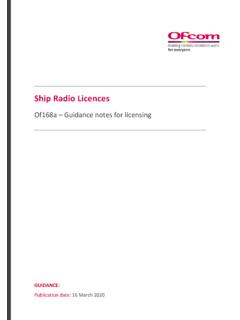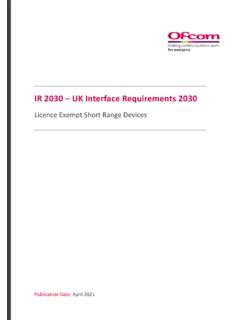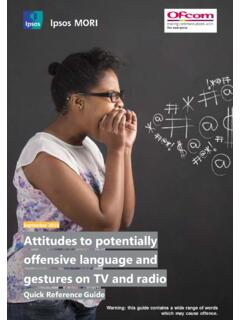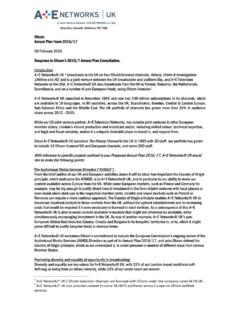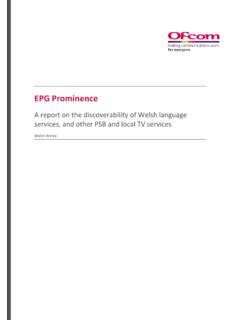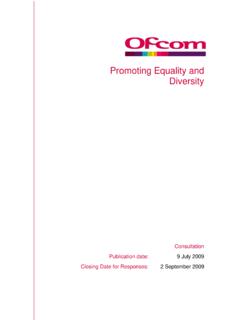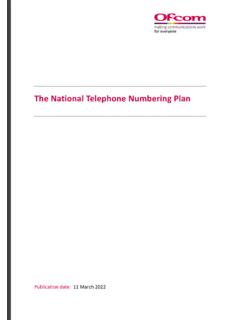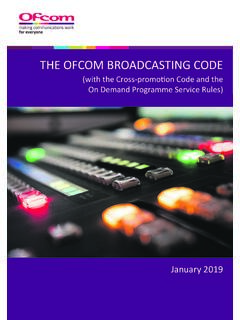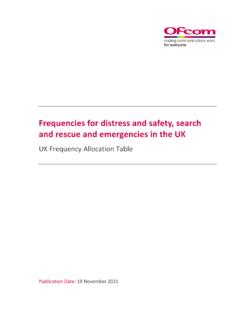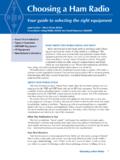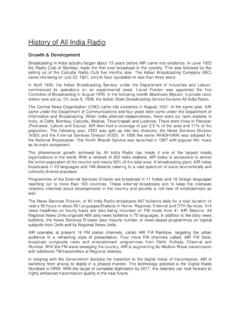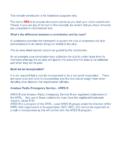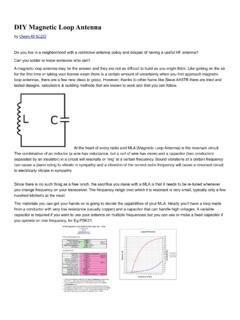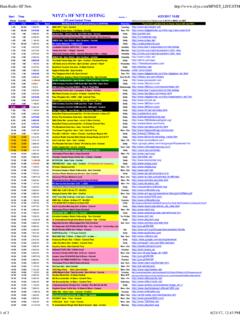Transcription of Amateur radio guidance - Ofcom
1 Amateur radio Licence guidance for licensees guidance : Publication Date: 15 October 2018. About this document About this guidance Ofcom has published this guidance to help Amateur radio licensees understand and comply with the terms and conditions of the UK Amateur radio Licence. This should therefore be read in conjunction with the Licence. Following the guidance should help licensees reduce the risk of breaching the terms and conditions of the Licence. The guidance is not, however, intended to be relied upon as legal advice, nor does Ofcom give advice to licensees on individual cases. Licensees should seek their own independent legal advice as required in order to ensure compliance. The guidance is not legally enforceable. It does not impose additional licence conditions or modify the effect of the existing terms and conditions of the Licence. Further, the guidance is not intended to be a new version of the BR68 Licence Conditions booklet, which was superseded by the introduction of the current licensing regime.
2 Changes and updates to this guidance This version of the guidance was published in October 2018. The guidance may be amended or updated from time to time, for example to reflect changes in common practice or procedures, advances in technology or changes to internat- ional agreements. Each version will include its date of publication and will be accompanied by an announcement. Licensees should check Ofcom 's website to ensure that they have the most up-to-date version. In addition to this guidance , Ofcom will continue to publish advice on specific aspects of Amateur radio , such as the more detailed requirements regarding the GHz and GHz bands. Contents Section 1. Licence details 1. 2. Terms, conditions and limitations 5. Annex A1. Glossary 26. Amateur radio Licence - guidance 1. Licence details The different types and classes of Amateur radio Licences The terms and conditions of the Amateur radio Licence apply to all licensees and operators, depending on the Licence class stated in Section 1 of the Licence.
3 A Licence is either Foundation', Intermediate', or Full'. In the case of a Full' Licence, the terms and conditions set out in the Licence apply to all types of Full Licences, including club Licences and Temporary Reciprocal Licences, unless the Licence expressly states otherwise. Although it is not currently a condition of the Licence and is not currently required in order to obtain a licence, it helps us to ensure that our records are up-to-date if licensees surrender the lower class of Licence, when progressing from one class to the next. This makes it easier for us to manage licence records. The Licence shows the CEPT equivalent licence class', which relates to the European Conference of Postal and Telecommunications Administrations ( CEPT') Recommendation T/R 61-01 1. Under that Recommendation, we have reciprocal agreement with other countries that holders of the highest class of licence may operate in other participating countries.
4 This is explained further below, in the guidance to Licence Clause 16. Licensee's name This is the name of the person to whom the Licence has been issued. The licensee is ultimately answerable for the operation of the station that the Licence covers, be it a personal station (most cases) or a club station. club licences If a licence is a Full ( club ) Licence, it is still issued to an individual person. That is because different clubs may be constituted differently, making accountability unclear. The club is named on the front of the Licence. Where Ofcom issues a Full ( club ) Licence, the individual person named in Section 1 will be authorised to hold the Licence to the extent that he or she represents the named club . This is stated beneath the table containing the licence details. It makes plain that, although the Licence has been issued to an individual person, it is being held for the purposes of the activities of the club .
5 Should that individual cease to be associated with the club and Ofcom were satisfied that the licensee no longer represented the club , we may seek to revoke the Licence. We could 1 1. Amateur radio Licence - guidance then issue a new Full ( club ) Licence, so that club members could continue to use their existing call sign. However, until any such revocation had taken place, the terms and conditions of the existing Licence would continue to apply. This means that until or unless the licence had been revoked, the club 's call sign could only be used with the permission of the named licensee. This is explained further, in the guidance , below, to Clause 4(2)(g). If the holder of a Full ( club ) Licence dies, the Licence dies with them. In that case, another club member must apply for a fresh licence and the application must be supported by two other club officials. The application should also be accompanied by evidence that the erstwhile licensee has died, together with a note of the club 's call sign.
6 Any replacement licence will authorise use of the same call sign, to ensure that the club 's identity remains consistent. We cover this in greater detail in the guidance to Clause 4, below, on revoking a licence. A request to make a change to a Full ( club ) licence, must be submitted on the Amateur radio Licence amendment form, Of346a 2. This is because the form includes a formal declaration that the licensee has due authority to request the change. In the case of a Full ( club ) licence, this might mean that, for example, a meeting of the club agreed that the licensee should request the change. If it were subsequently to emerge that the licensee did not have due authority to request the change, we may reverse the change and the licence would revert to the details that applied before that original change. Call sign The UK Amateur radio Licence reflects the applicable requirements of the ITU radio Regulations ( RRs )3 for Amateur radio stations to be clearly identified with a call sign.
7 The RRs also expressly prohibit misleading identities. Amateur radio stations have global reach and it must be possible for overseas stations or authorities readily to identify the source of a transmission, for example if it is causing interference. The call signs that Ofcom issues for normal operation under the Amateur radio Licence are made up of an initial character G', M' or 2' (denoting that a station is authorised by the UK), followed by a number and then, normally, three letters. Very old call signs, some of which remain in use, have only two trailing letters. The call sign that we issue shows the level of the station, as set out in the table below. Call sign initial characters Station level Currently issuing: M7. Foundation Formerly issued: M3, M6. Currently issuing: 2#0. Intermediate 4. Formerly issued: 2#1. Currently issuing: M0 Full Formerly issued: M1, M5, G1, G2, G3, G4, G5, G6, G7, G8, G0 (all types).
8 2 3 radio Regulations see Glossary 4 The symbol #' is included to indicate that the transmitted call sign must always include an RSL. 2. Amateur radio Licence - guidance In some cases, the call sign that is transmitted must be enhanced with a Regional Secondary Locator ( RSL ), inserted between the initial letter and the number. This is explained below, in the guidance to Clause 2(2). In the past, some of the call signs that were printed on the face of the Licence included an RSL. However, some did not. This was usually the RSL of the part of the UK in which the Main Station Address was located. In view of the inconsistency and the scope for confusion, we now insert the hash character ( #') into the call sign printed on the face of the Licence. As is stated in the text in the call sign box the #' should be replaced by an RSL, if one is to be used. The #' shows where to place the RSL, if it is to be used. In the case of an Intermediate Licence, the call sign that is transmitted must always include an RSL, even in England.
9 We explain this below, in the guidance to Clause 2(3). Other call signs Ofcom sometimes authorises a radio Amateur to use different types of call signs in addition to (or as an alternative to) the call sign on the face of the licence. This could be a Special Contest Call sign or a Special Event Station call sign. Where this has been authorised (normally by varying the individual licence), the format will differ from those described above. Reusing old call signs As a matter of conventional practice, we do not normally recycle call signs that have been used in the past. However, this is not to say that we would not do so. If the holder of an Amateur radio Licence were to die, we would not normally consider making the associated call sign available for reassignment to a new licensee, until a reasonable period of time had elapsed. This is because the identity would remain linked with the former station for some time. If the holder of an Amateur radio Licence were to take a break from the hobby (surrendering his or her licence) but subsequently reapplied for an Amateur radio Licence, they may resume use of the old call sign, if it remains available.
10 Changing and transferring call signs We assign each station a unique identifier - its call sign. This enables us to meet our obligations under the RRs, which require stations to be clearly identifiable and which expressly prohibit misleading identities. Being unique, these call signs may not be changed or transferred, other than in exceptional circumstances (perhaps where a licensee has acquired a physical or mental impairment that prevents him or her from using the original call sign). These cases are, however, very rare. 3. Amateur radio Licence - guidance Mailing (postal) address, Main station address Under Clause 6 of the Licence, the licensee must notify us of any change to the main station or contact addresses or to the name of the licensee. Inaccurate details hamper our ability to manage the radio spectrum. We may consider revoking a Licence if a licensee fails to maintain these details. This is explained further, below, in the guidance to Clause 4.
